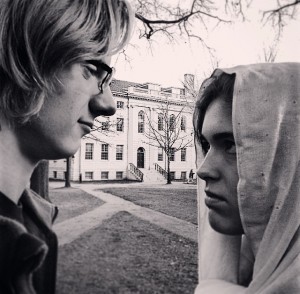Samina Ali’s Madras on Rainy Days addresses concepts of gender, sexuality, and society. In the novel, Layla and Sameer are forced into a union of marriage by their parents’ wishes. However, their commitments are not to one another. Sameer is homosexual and desires to live in America to finally be free of societal repressions. He wants to embrace his sexuality and not be afraid to show the world who he really is. On the other hand, Layla struggles with her identity. Her parents are Indian, but she goes to school in America. She is constantly walking on the edge of both cultures, trying desperately to fit into open-minded, liberal, free-thinking America and conservative, tradition-based, one-minded India. Both Layla and Sameer struggle in trying to discover where they belong, and try to break free from conforming to society.
In order to reflect on these themes and comment on my own perspective of these ideas, I decided to capture my thoughts in a photograph. Depicted in this photograph (of two of my very helpful entryway mates!) is a tension caused from many sources. The man is shown taller than the woman, almost shadowing her, symbolizing how men are often viewed as superior in society. The light shines on his face, while her face is shown in the shade. This represents how the voices of women were often silenced. However, there is light all around her, demonstrating how she is desperately trying to break free from this societal norm. She is wearing a white veil, symbolizing the veil of purity women are expected to wear until marriage. The fury in her eyes shows her resistance to society’s norms and how even though she does not agree with society, she is forced to wear a façade of submissiveness. On the other hand, the man is shown in dark colors, expressing his internal conflict about his own sexuality and identity. His face is calm, but full of hopelessness. He looks vulnerable. Society views men as stronger, more certain, not vulnerable. But the expressions in his eyes reveal a vulnerability imposed by society’s harsh social constructs. The man and the woman are close to one another, but there is a distance between them. This shows how even though they are different; they are still one and the same. In the distance, there are two paths that converge into one. This convergence represents how even though their paths are different, they still lead to one common dream: they both want to discover themselves and be accepted for who they are.
